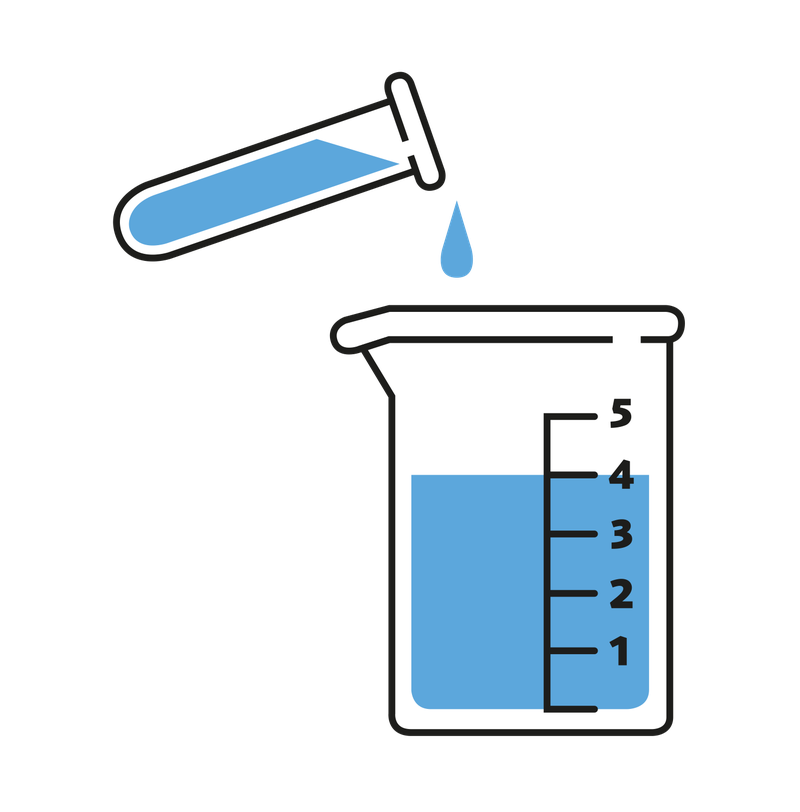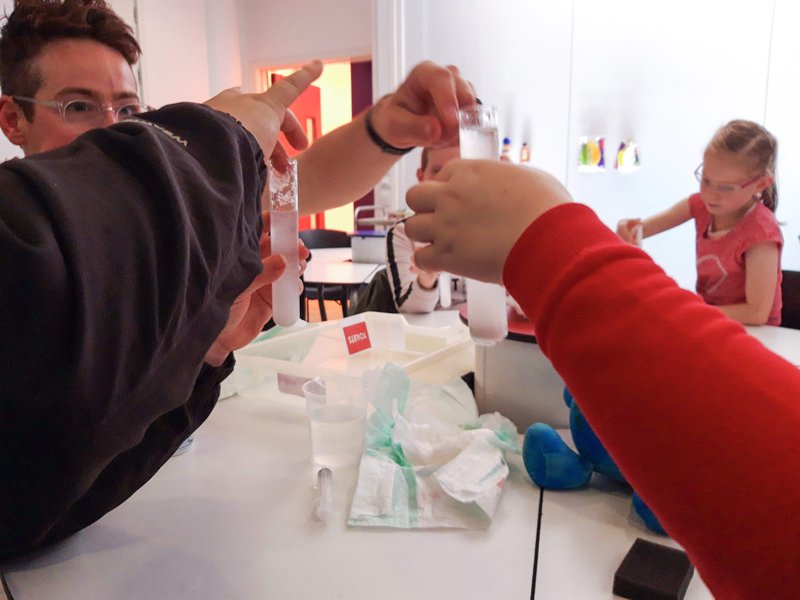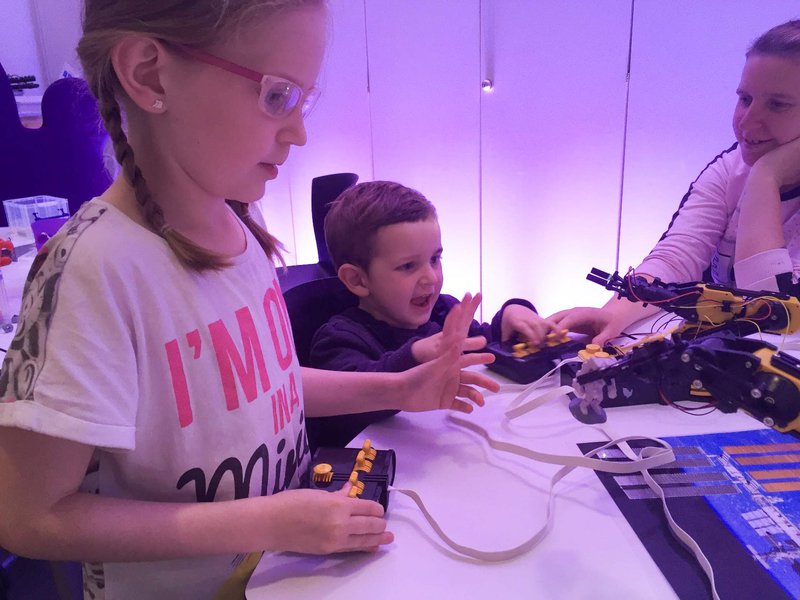Edinburgh Young Carers work with Dynamic Earth
Dynamic Earth worked with Edinburgh Young Carers (EYC), a community organisation supporting young people with caring responsibilities for a family member.
Who did you work with?
We worked with Edinburgh Young Carers (EYC) who are a community organisation supporting young people aged 5-20 who experience caring responsibilities for a family member, usually a parent or sibling. This of course has a huge impact of many areas of the young peoples’ lives, including recreational time, learning, and general respite.
In the initial stages of the project, we worked closely with 3 families over a 5-week period. These sessions took place within Dynamic Earth, with one outing to The Royal Observatory, Edinburgh – our local hub of STFC science and research.
As a direct result of this initial phase, we were invited by EYC to provide ‘STEM care packages’ for a further 15 families who the EYC team identified would most benefit from home learning resources, games and reading materials during the first COVID-19 lockdown.
Had you worked together before?
Dynamic Earth and Edinburgh Young Carers have a long history of working together, but this had always been on a more superficial basis built around one-off visits to the centre. Changes within staff teams on both sides also meant the relationship stalled on occasion and often required a re-set of sorts.
What goals, values or priorities did you share with your partner that meant you worked well together?
Using partnership tools specifically supplied by ASDC for the project, our team at Dynamic Earth and the EYC team quickly identified that one main shared priority was to provide the young people with a fun opportunity for respite and family interaction. It was also important to all of us that the young people were agents of their own learning, having the opportunity to decide on topics for exploration, and to control how far we went with each one. As the sessions progressed, it was realised between us all that there was a lot of cross-over between STEM engagement practices and family development work. I believe that this further strengthened our partnership and teamwork.
Can you summarise the aims of your project delivery in 2(ish) sentences?
One aim was to discover if multiple, repeat interactions with a small cohort of families - focussed on relationship development and participatory methodologies – could provide learnings that would shape practices within Dynamic Earth. We also aimed to build on our long-running relationship with EYC in order to have a greater impact on the young peoples’ access to learning opportunities and greater wellbeing.

How co-produced was your programme?
- Information shared (the offer is decided and provided by you as the lead partner and people join to hear information)
- Consultation (the community partner/participants choose from a range of options, involving listening, feedback and discussion, but broader project objectives and delivery are led by you)
- Deciding together (community partners/participants support the creation and design phase, bringing new options and joint decision-making. Delivery and evaluation/reporting is led by you as the lead partner)
- Acting together (involvement of community partner/participant at each stage - from the planning and design, to the delivery and evaluation – with shared decision-making that forms a partnership to carry out the full programme)
- Supporting independent community interest (supporting partner agency, including offered funding, advice, and support to develop the independent ideas and agendas of the community partner).
“It was easy to come along and get involved, so yeah, I felt like I belonged here. If there were more people here maybe I wouldn’t have come.”
Comment from mother
Can you note down some of the benefits and challenges to working this way?
The first obvious benefit came in the form of the sustained interest from the families involved in the in-person sessions. The three families that we worked closely with represented some of the most disadvantaged families that Edinburgh Young Carers supported, with them experiencing a multitude of societal deprivations on top of physical and mental health challenges. Despite this, and even though the families themselves did not express a high level of interest in science learning, they returned week after week, provided positive feedback on their experiences, and reported learning together as a family like they never had before.
A challenge shared by Edinburgh Young Carers and Dynamic Earth was the time commitment needed beyond the running of the actual sessions or the distribution of resources to families’ homes. We needed a lot of partnership meetings which were sometimes difficult to schedule, and of lower priority for EYC amongst their complex casework.
“It was easy to come along and get involved, so yeah, I felt like I belonged here. If there were more people here maybe I wouldn’t have come.”
Comment from a mother

What was the science link?
Based off the interests of the participants, as established during a consultation phase held early on, we focussed mostly on space exploration from astrophysics to human space flight. This culminated in a group visit to the observatory to speak with STFC researchers and engagement staff.
What happened?
A major success directly linked to the participant families was the novel interactions that happened between the young people and their parents. Dynamic Earth and Edinburgh Young Carers staff were witness to several moments that made all the hard work particularly worth it, from parents helping their child to explore an activity, to children and parents creating things such as scrapbooks together. These interactions were not previously a normal part of the families’ interactions with one another and so in these moments we felt the impact of the project taking shape.

What challenges might lie in wait for someone wanting to replicate this project?
I think that finding a community partner able to put so much into the partnership will always be a challenge. I believe that we were only able to do what we did because Edinburgh Young Carers understood Dynamic Earth and trusted our team due to the dozens of previous interactions, that they had had with us over the years. Therefore, my learning from this is that to replicate this with another partner organisation will first require a period of relationship building with no fixed agenda or expected outcomes, designed only to build familiarity and trust so that they can see sessions with us a standard part of their work.
Where there any surprises?
After just the first week, we realised that younger siblings, some of which had complex needs, created a barrier to the older children interacting with their parents. For this reason, we agreed with EYC team that we could provide more Dynamic Earth staff to help entertain the younger siblings in an early-years appropriate ‘zone’ set up within the learning space. This was not something we had anticipated having to do in our original planning, but was one which had the desired effect of freeing up the parents to interact with their older child.

How did you capture/measure the impact for this project?
We used the EYU4 Evaluation Tools. The Blob Characters were used frequently to gauge the immediate feelings of individuals. Sometimes this got us talking and we were able to tease out more information.
Both Dynamic Earth and Edinburgh Young Carers staff filled out reflection journals following meetings and sessions which really helped to capture feelings around the direction the project and partnership was going in. Partnership Tracking Cards were also for this purpose and helped us to align our goals and purposes.
We also used a variety of paperless evaluation methods with the families, such as having the young people ‘vote’ on how they felt about an activity or what they would like to do next using stickers, sliding scales or placing balls into marked tubes!
Face to face conversations with the families and our community partner were also a vital tool in capturing favourite moments, reflections and feelings.
“It has been such a successful project, it would be good to continue on with the current families and try and get more on board and we can introduce a peer learning aspect.”
Edinburgh Young Carers practitioner
Where is the long-lasting change?
Following the completion of the project, we have continued to work with Edinburgh Young Carers extensively. During the multiple covid-19 lockdowns, the STEM Care Packages began as a legacy of the EYU project, continuing the link to STFC science and research, but were quickly followed up with other packages exploring other areas of STEM as suggested by EYC practitioners. EYC young people were also amongst some of the first to return to our centre during our period of phased reopening, engaging in outdoor learning activities, book groups and more.
As a centre, this project has remained at the centre of the operational focus on Equity, Diversity and Inclusion. It has also drawn a lot of attention from the Scottish Government who are keen to see projects that align with their widening participation agenda. This has therefore allowed for resources to be directed towards co-development and long-term relationship development with community partners.
Please see below the Evaluation Report: Relationship + Engagement = Impact. Lessons learned from the evaluation of Explore Your Universe 4 written by Jen DeWitt.
